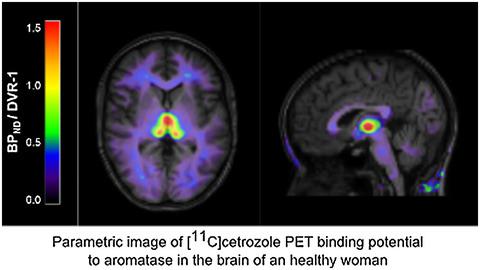当前位置:
X-MOL 学术
›
J. Neurosci. Res.
›
论文详情
Our official English website, www.x-mol.net, welcomes your
feedback! (Note: you will need to create a separate account there.)
Quantification of aromatase binding in the female human brain using [11 C]cetrozole positron emission tomography.
Journal of Neuroscience Research ( IF 2.9 ) Pub Date : 2020-08-06 , DOI: 10.1002/jnr.24707 My Jonasson 1, 2 , Patrik Nordeman 3, 4 , Jonas Eriksson 3, 4 , Helena Wilking 4 , Johan Wikström 1 , Kayo Takahashi 5 , Takashi Niwa 5 , Takamitsu Hosoya 5, 6 , Yasuyoshi Watanabe 5 , Gunnar Antoni 3, 4 , Inger Sundström Poromaa 7 , Mark Lubberink 1, 2 , Erika Comasco 8
Journal of Neuroscience Research ( IF 2.9 ) Pub Date : 2020-08-06 , DOI: 10.1002/jnr.24707 My Jonasson 1, 2 , Patrik Nordeman 3, 4 , Jonas Eriksson 3, 4 , Helena Wilking 4 , Johan Wikström 1 , Kayo Takahashi 5 , Takashi Niwa 5 , Takamitsu Hosoya 5, 6 , Yasuyoshi Watanabe 5 , Gunnar Antoni 3, 4 , Inger Sundström Poromaa 7 , Mark Lubberink 1, 2 , Erika Comasco 8
Affiliation

|
Aromatase, the enzyme that in the brain converts testosterone and androstenedione to estradiol and estrone, respectively, is a putative key factor in psychoneuroendocrinology. In vivo assessment of aromatase was performed to evaluate tracer kinetic models and optimal scan duration, for quantitative analysis of the aromatase positron emission tomography (PET) ligand [11C]cetrozole. Anatomical magnetic resonance and 90‐min dynamic [11C]cetrozole PET‐CT scans were performed on healthy women. Volume of interest (VOI)‐based analyses with a plasma‐input function were performed using the single‐tissue and two‐tissue (2TCM) reversible compartment models and plasma‐input Logan analysis. Additionally, the simplified reference tissue model (SRTM), Logan reference tissue model (LRTM), and standardized uptake volume ratio model, with cerebellum as reference region, were evaluated. Parametric images were generated and regionally averaged voxel values were compared with VOI‐based analyses of the reference tissue models. The optimal reference model was used for evaluation of a decreased scan duration. Differences between the plasma‐input‐ and reference tissue‐based methods and comparisons between scan durations were assessed by linear regression. The [11C]cetrozole time–activity curves were best described by the 2TCM. SRTM nondisplaceable binding potential (BPND), with cerebellum as reference region, can be used to estimate [11C]cetrozole binding and generated robust and quantitatively accurate results for a reduced scan duration of 60 min. Receptor parametric mapping, a basis function implementation of SRTM, as well as LRTM, produced quantitatively accurate parametric images, showing BPND at the voxel level. As PET tracer, [11C]cetrozole can be employed for relatively short brain scans to measure aromatase binding using a reference tissue‐based approach.
中文翻译:

使用 [11 C]cetrozole 正电子发射断层扫描对女性人脑中的芳香酶结合进行量化。
芳香酶是大脑中将睾酮和雄烯二酮分别转化为雌二醇和雌酮的酶,是心理神经内分泌学中公认的关键因素。进行芳香酶的体内评估以评估示踪剂动力学模型和最佳扫描持续时间,用于芳香酶正电子发射断层扫描 (PET) 配体 [ 11 C] cetrozole 的定量分析。解剖磁共振和 90 分钟动态 [ 11对健康女性进行 C]cetrozole PET-CT 扫描。使用单组织和双组织 (2TCM) 可逆隔室模型和血浆输入 Logan 分析使用血浆输入函数进行基于感兴趣体积 (VOI) 的分析。此外,还评估了以小脑为参考区域的简化参考组织模型 (SRTM)、Logan 参考组织模型 (LRTM) 和标准化摄取体积比模型。生成参数图像,并将区域平均体素值与参考组织模型的基于 VOI 的分析进行比较。最佳参考模型用于评估减少的扫描持续时间。通过线性回归评估血浆输入方法和参考组织方法之间的差异以及扫描持续时间之间的比较。[ 11C]cetrozole 时间-活性曲线最好由 2TCM 描述。SRTM 不可置换结合电位 (BP ND ),以小脑为参考区域,可用于估计 [ 11 C] cetrozole 结合,并在减少 60 分钟的扫描持续时间的情况下生成稳健且定量准确的结果。受体参数映射,SRTM 和 LRTM 的基函数实现,产生定量准确的参数图像,在体素级别显示 BP ND。作为 PET 示踪剂,[ 11 C]cetrozole 可用于相对较短的脑部扫描,以使用基于参考组织的方法测量芳香酶结合。
更新日期:2020-10-04
中文翻译:

使用 [11 C]cetrozole 正电子发射断层扫描对女性人脑中的芳香酶结合进行量化。
芳香酶是大脑中将睾酮和雄烯二酮分别转化为雌二醇和雌酮的酶,是心理神经内分泌学中公认的关键因素。进行芳香酶的体内评估以评估示踪剂动力学模型和最佳扫描持续时间,用于芳香酶正电子发射断层扫描 (PET) 配体 [ 11 C] cetrozole 的定量分析。解剖磁共振和 90 分钟动态 [ 11对健康女性进行 C]cetrozole PET-CT 扫描。使用单组织和双组织 (2TCM) 可逆隔室模型和血浆输入 Logan 分析使用血浆输入函数进行基于感兴趣体积 (VOI) 的分析。此外,还评估了以小脑为参考区域的简化参考组织模型 (SRTM)、Logan 参考组织模型 (LRTM) 和标准化摄取体积比模型。生成参数图像,并将区域平均体素值与参考组织模型的基于 VOI 的分析进行比较。最佳参考模型用于评估减少的扫描持续时间。通过线性回归评估血浆输入方法和参考组织方法之间的差异以及扫描持续时间之间的比较。[ 11C]cetrozole 时间-活性曲线最好由 2TCM 描述。SRTM 不可置换结合电位 (BP ND ),以小脑为参考区域,可用于估计 [ 11 C] cetrozole 结合,并在减少 60 分钟的扫描持续时间的情况下生成稳健且定量准确的结果。受体参数映射,SRTM 和 LRTM 的基函数实现,产生定量准确的参数图像,在体素级别显示 BP ND。作为 PET 示踪剂,[ 11 C]cetrozole 可用于相对较短的脑部扫描,以使用基于参考组织的方法测量芳香酶结合。











































 京公网安备 11010802027423号
京公网安备 11010802027423号